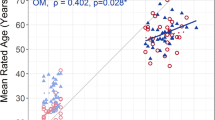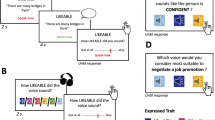Abstract
Two studies extended the study of the nonverbal correlates of age stereotypes. In Study 1, 40 young listeners assessed the age of 30 elderly speakers from three age groups: 60–69, 70–79, 80 and over. As expected, perceived age increased linearly with age group, although greater variability was found in judgments of male than of female speakers. For male speakers, mean vocal volume (intensity) and standard deviations in vocal volume were positively correlated with chronological and perceived age. For female speakers, mean pitch, standard deviations in pitch, and vocal jitter were positively correlated with chronological and perceived age. In Study 2, 40 young listeners selected trait sets corresponding to 3 positive and 3 negative elderly stereotypes to describe 6 young-old and 6 old-old speakers. As predicted, listeners associated the old-old voices of females (but not males) with fewer positive stereotypes than the young-old female voices. In addition, young-old male voices were associated with significantly fewer positive stereotypes than young-old female voices. Finally, male participants chose fewer positive stereotypes for young-old male voices than did female participants. These results provide information on the ways in which vocal characteristics may serve to activate stereotypes in interaction.
Similar content being viewed by others
References
Benjamin, B. J. (1981). Frequency variability in the aged voice. Journal of Gerontology, 36, 722–726.
Benjamin, B. J. (1986). Dimensions of the older female voice. Language and Communication, 6, 35–45.
Branscombe, N. R., Wann, D. L., & Noel, J. G. (1993). In-group or out-group extremity: Importance of the threatened social identity. Personality and Social Psychology Bulletin, 19, 381–388.
Brewer, M. B., Dull, V., & Lui, L. (1981). Perceptions of the elderly: Stereotypes as prototypes. Journal of Personality and Social Psychology, 41, 656–670.
Brewer, M. B., & Lui, L. (1984). Categorization of the elderly by the elderly. Personality and Social Psychology Bulletin, 10, 585–595.
Brown, B. L., Strong, W. J., & Rencher, A. C. (1974). Fifty-four voices from two: The effects of simultaneous manipulations of rate, mean fundamental frequency, and variance of fundamental frequency on ratings of personality from speech. Journal of the Acoustic Society of America, 55, 313–318.
Burgoon, J. K. (1994). Nonverbal signals. In M. L. Knapp & G. R. Miller (Eds.), Handbook of interpersonal communication (2nd ed., pp. 229–285). Thousand Oaks, CA: Sage.
Chevrie-Muller, C., Perbos, J., & Guilet, C. (1983). Automated analysis of the electroglot-tographic signal: Application to the study of phonation in the elderly. Aging Communication Bulletin Audiophonology, 16, 121–144.
Coupland, N., Coupland, J., Giles, H., & Henwood, K. (1988). Accommodating the elderly: Invoking and extending a theory. Language and Society, 17, 1–41.
Giles, H., Henwood, K., Coupland, N., Harriman, J., & Coupland, J. (1992). Language attitudes and cognitive mediation. Human Communication Research, 18, 500–527.
Helfrich, H. (1979). Age markers in speech. In K. R. Scherer & H. Giles (Eds.), Social markers in speech (pp. 63–107). Cambridge, England: Cambridge University Press.
Hollien, H. (1987). “Old voices”: What do we really know about them? Journal of Voice, 1, 2–17.
Hollien, H., & Shipp, T. (1972). Speaking fundamental frequency and chronological age in males. Journal of Speech and Hearing Research, 15, 155–159.
Hummert, M. L. (1990). Multiple stereotypes of elderly and young adults: A comparison of structure and evaluations. Psychology and Aging, 5, 183–193.
Hummert, M. L. (1994a). Physiognomic cues to age and the activation of stereotypes of the elderly in interaction. International Journal of Aging and Human Development, 39, 5–19.
Hummert, M. L. (1994b). Stereotypes of the elderly and patronizing speech. In Hummert, M. L., Wiemann, J. M., & Nussbaum, J. F. (Eds.), Interpersonal communication in older adulthood: Interdisciplinary theories and research (pp. 162–184). Belmont, CA: Sage.
Hummert, M. L., Garstka, T. A., & Shaner, J. L. (1997). Stereotyping of older adults: The role of target facial cues and perceiver characteristics. Psychology and Aging, 12, 107–111.
Hummert, M. L., Garstka, T. A., Shaner, J. L., & Strahm, S. (1994). Stereotypes of the elderly held by young, middle-aged and elderly adults. Journal of Gerontology: Psychological Sciences, 49, P240–P249.
Huntley, R., Hollien, H., & Shipp, T. (1987). Influences of listener characteristics on perceived age estimations. Journal of Voice, 1, 49–52.
Kay Elemetrics (1996). Multi-speech Model 3700. Lincoln Park, NJ: Kay Elemetrics Corp.
Kenny, D. A. (1987). Statistics for the social and behavioral sciences. Boston: Little, Brown.
Kenny, D. A. (1991). A general model of consensus and accuracy in interpersonal perception. Psychological Review, 98, 155–163.
Kite, M. E., Deaux, K., & Miele, M. (1991). Stereotypes of old and young: Does age outweigh gender? Psychology and Aging, 6, 19–27.
Kogan, N., & Mills, M. (1992). Gender influences on age cognitions and preferences: Sociocultural or sociobiological? Psychology and Aging, 7, 98–106.
Lawton, P. (1972). Assessing the competence of older people. In D. Kent, R. Kastenbaum, & S. Sherwood (Eds.), Research planning and action for the elderly (pp. 122–143). York: Behavioral Publications.
McGlone, R. E., & Hollien, H. (1963). Vocal pitch characteristics of aged women. Journal of Speech and Hearing Research, 6, 164–170.
Meyerson, M. D. (1976). The effects of aging on communication. Journal of Gerontology, 31, 29–38.
Montepare, J. M., Steinberg, J., & Rosenberg, B. (1992). Characteristics of vocal communication between young adults and their parents and grandparents. Communication Research, 19, 479–492.
Mulac, A., & Giles, H. (1996). “You're only as old as you sound”: Perceived age vocal age and social meanings. Health Communication, 8, 199–215.
Mysak, E. D. (1959). Pitch and duration characteristics of older males. Journal of Speech and Hearing Research, 2, 46–54.
Mysak, E. D., & Hanley, T. D. (1958). Aging processes in speech: Pitch and duration characteristics. Journal of Gerontology, 13, 309–313.
Pittam, J. (1994). Voice in social interaction: An interdisciplitary approach. Thousand Oaks, CA: Sage.
Ptacek, P. H., & Sander, E. K. (1966). Age recognition from voice. Journal of Speech and Hearing Research, 9, 273–277.
Ptacek, P. H., Sander, E. K., Maloney, W. H., & Jackson, C. C. R. (1966). Phonatory and related changes with advanced age. Journal of Speech and Hearing Research, 9, 353–360.
Ryan, E. B., Anas, A. P. Hummert, M. L., & Laver-Ingram, A. (1998). Young and older adults' views of telephone talk: Conversation problems and social uses. Journal of Applied Communication Research, 26, 83–98.
Ryan, E. B., & Capadano, H. L. (1978). Age perceptions and evaluative reactions toward adult speakers. Journal of Gerontology, 33, 98–102.
Ryan, E. B., Giles, H., Bartolucci, G., & Henwood, K. (1986). Psycholinguistic and social psychological components of communication by and with the elderly. Language and Communication, 6, 1–24.
Ryan, E. B., Hummert, M. L., & Boich, L. H. (1995). Communication predicaments of aging: Patronizing behavior toward older adults. Journal of Language and Social Psychology, 14, 144–166.
Ryan, E. B., & Laurie, S. (1990). Evaluations of older and younger adult speakers: The influence of communication effectiveness and noise. Psychology and Aging, 5, 513–518.
Ryan, W. J. (1972). Acoustic aspects of the aging voice. Journal of Gerontology, 27, 265–268.
Schmidt, D. F., & Boland, S. M. (1986). The structure of impressions of older adults: Evidence for multiple stereotypes. Psychology and Aging, 1, 255–260.
Stewart, M. A., & Ryan, E. B. (1982). Attitudes toward younger and older adult speakers: Effects of varying speech rates. Journal of Language and Social Psychology, 1, 91–109.
Willis, S. L. (1996). Everyday cognitive competence in elderly persons: conceptual issues and empirical findings. The Gerontologist, 36, 595–601.
Winer, B. J. (1971). Statistical principles in experimental design (2nd ed.). New York: McGraw Hill.
Author information
Authors and Affiliations
Rights and permissions
About this article
Cite this article
Lee Hummert, M., Mazloff, D. & Henry, C. Vocal Characteristics of Older Adults and Stereotyping. Journal of Nonverbal Behavior 23, 111–132 (1999). https://doi.org/10.1023/A:1021483409296
Issue Date:
DOI: https://doi.org/10.1023/A:1021483409296




